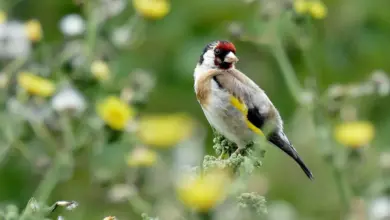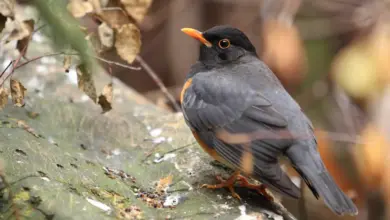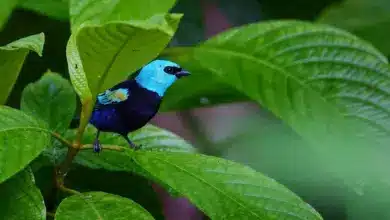Flammulated Owl (Otus flammeolus)
The Flammulated Owls (Otus flammeolus) are amongst the smallest owls in the world. These predatory owls are found in the Americas, where they are also known as Dwarf Owls, Flammulated Scops Owls, or (previously) Flammulated Screech Owls.
This species’ common and Latin names were derived from the reddish “flaming” streaks of feathers along the shoulders and onto the back.
They breed from southern British Columbia and the western United States to central Mexico. It is the most migratory owl in North America, leaving their breeding territories in the fall to winter in Central America.
These nocturnal birds hunt at night and spend the daytime roosting in cavities or some other protected areas.
Distribution / Range
Flammulated Owls breed in North America – from south-central British Columbia in southwestern Canada, south along the Rocky Mountains to northwestern and southwestern United States, and northeastern, western, and central Mexico, as well as east in the highlands to southern Puebla and northeastern Oaxaca.
In August or early September, they migrate south to winter in central and southern Mexico, Guatemala, El Salvador, and possibly Honduras.
Resident populations are found in southern Mexico.
They are typically found in open coniferous mountain forests, particularly in areas with ponderosa and yellow pines, quite often mixed with oak or aspen trees; as well as mixed forests with Douglas- fir, white fir, incense cedar, or sugar pine trees. The areas are typically characterized by brushy undergrowth and range in elevation from 1,300 – 9,850 feet (400 – 3,000 meters).
As is typical for owls, they are active at night (nocturnal) and by day roost close to tree trunks, where they are well camouflaged by their greyish-brown plumage against the branches. They are typically found in pairs.
Description
The Flammulated Owls are amongst the world’s smallest owls – weighing only about 1.6 – 2.2 oz (45 – 63 grams), measuring about 6.3 – 7.7 inches (16 – 17 cm) in length and having a wingspan of about 5.2 – 5.9 inches (13.3 – 14.9 cm). The tail is about 2.6 – 2.7 inches (6.6 – 6.9 cm long). The only owls smaller than them are the Pygmy Owls, followed by the Elf Owls.
They have big, round heads with greyish bills and small ear tufts. The facial disk is greyish-brown, washed with pale chestnut or rusty brown; the facial disk begins at the ears and ends at the moustache.
Two color morphs (phases) have been identified:
- Grey Morph: Those found in the Great Basin mountains have a mostly greyish plumage and the coarsest markings; and the back is mainly grey, except for the reddish-brown feathers on the back of the neck, and on the flight feathers.
- Red Morph: Those occurring in the southeast are reddish. The back is reddish-brown.
The plumage below both color morphs is generally blotched with grey, black, and reddish-brown. The dark-streaked patterns of the plumage blend well with the bark of the trees where they typically roost.
The legs and toes are feathered greyish-brown and the claws are blackish-brown. Their eyes (irises) are brown.
Gender ID:
The females tend to be larger than males but are otherwise identical in appearance. The females can best be identified by their higher-pitched whining calls.
Juveniles:
Immature birds have a greyish upper body. The plumage below is a dull white or greyish white, barred with a greyish-rust color.
Similar Species:
The Flammulated Owls resemble the similar-sized Western Screech Owl but lack the large ear tufts. They also have darker eyes and different vocalizations. The Western Screech Owl’s range is also different.
In general, their small size, eye color, head shape, and short ear tufts set them apart from all North American Megascops owl species. The wings are longer and more pointed compared to other species in the genus. One key field mark is the streak of reddish feathers along the shoulder and onto the back. This “flaming” streak is what gives this bird its Latin and common names.
Their low-pitched, soft, monosyllabic hooting calls resemble those of the Long-eared Owls (Asio otus).
Calls / Vocalizations
The calls of the males are described as a series of relatively deep single or double hoot, woop, poop, or pooip, repeated at intervals of about 2-3 seconds.
These calls are typically preceded by one or two preliminary, lower-pitched ‘grace’ notes. The vocalizations of females are higher-pitched, longer in duration and more quavering (McCallum 1994).
Their mating or courtship calls are two-syllable boo-boot – given at about 1.5-second intervals.
Their sentinel or alarm calls are reminiscent of the meowing of a kitten.
Breeding / Nesting
Flammulated Owls tend to be monogamous; although they may take new mates if their previous mates disappear for whatever reason.
Breeding typically occurs in spring. Males will establish breeding territories – usually in areas with mature aspen, ponderosa, and pine trees. On occasion, breeding territories will overlap as several pairs nest close to one another. To initiate mating, males will attract females by singing to them.
Flammulated Owls generally nest in tree cavities, typically excavated by woodpeckers but also natural tree holes. They may also accept nest boxes.
Egg-laying occurs from about mid-April through the beginning of July.
A clutch consists of 1 up to 5 white, rounded eggs (mostly 2 – 3 eggs). The females alone incubate the eggs for about 21 – 26 days, while the males feed the brooding females.
Both parents feed and protect the young, which fledge (leave the nest) when they are about 3 – 5 weeks old.
The parents will continue to care for them for another 4 – 5 weeks after fledging, at which point the young become independent and disperse.
Diet / Feeding
Flammulated Owls mostly feed on insects, such as moths, beetles, crickets, grasshoppers, spiders, caterpillars, centipedes, scorpions, and millipedes. To a lesser extent, they will also eat mice, small birds, and other small prey.
They hunt their prey from perches, pouncing on them on the ground, capturing them in flight, or picking them off the foliage or trunks.
Feeding typically occurs at night, in particular at dusk or dawn.
Lifespan/Longevity
In the wild, they are expected to live about 7 – 8 years.
Alternate (Global) Names
Czech: Výrecek plaménkový, výre?ek plaménkový … Danish: Broget Dværghornugle … Dutch: Amerikaanse Dwergooruil, Amerikaanse-dwergooruil, Ponderosa-dwergooruil … Estonian: männipäll … Finnish: Ponderosapöllönen … French: Duc nain, Petit-duc d’Amérique, Petit-duc nain … German: Ponderosaeule, Ponderosa-Zwergohreule … Italian: Assiolo fiammato, Assiolo flammeolo … Japanese: amerikakonohazuku … Norwegian: Flammeugle … Polish: syczek ozdobny … Russian: ??????????????????? ?????, ???????? ?????, ????? ???????? … Slovak: výrcek ohnivý, výr?ek ohnivý … Spanish: Autillo de Gallardete, Autillo Flamulado, Tecolote Flameado, Tecolote Ojo Oscuro, tecolote ojo-oscuro … Swedish: Brunögd dvärguv
More Owl Information
- Owl Information
- Index of Owl Species with Pictures
- Owl Eyes / Vision Adaptations
- Pygmy Owls
- Barn Owls
- Horned Owls
- Scops Owls




